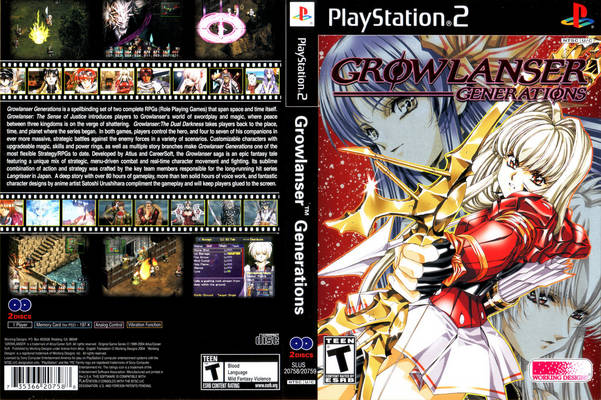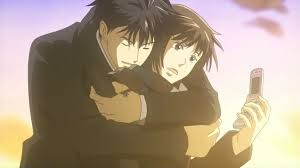Hang tight; things are going to get confusing if you’ve never heard of this series before. Growlanser Generations is the name of an American version of Growlanser II and III (that’s the one I’m reviewing below). BUT Growlanser Generations is the name of a Japanese game in the same game series, which is Growlanser V (and this game was also released in America as Growlanser Heritage of War, but I hate (or at least strongly dislike) that one, so I’m not reviewing it (at least not right now).
So Keep in mind, this is a review of Growlanser II and Growlanser III (Generations NA). And it is NOT a review of Growlanser V (Generations JP) Got it? Good 🙂
Title: Growlanser Generations
Publisher: Working Designs
Release Date: 2004
Platform: PS2
Genre: Strategy RPG with Dating Sim Elements
Where to buy: Amazon has a few available ranging in price from $65 to $95 depending on quality and deluxe or standard editions. You can browse whats available on this page here: http://www.amazon.com/Growlanser…
Geeky: 3/5
Sweetie: 5/5
Overall: 71/90 79% C+ “Good Game For Girls”
Concept: 7/10 Though packaged in America as a single game, this is originally two separate games (though from the same series) in Japan. Growlanser I was never released in America, which puts us at a disadvantage because Growlanser II’s story takes place at the same time as, and has the same characters as, Growlanser I. It is basically letting you play as the opponent’s army from the first game, to draw sympathy and give you another look at the war from a different view point. But since we never got Growlanser I in America (I’m sure Working Designs would have if they could, but this game actually was one of their last games and probably partly responsible for the ultimate demise of the company – selling two games, for the price of one, at the expense of double the staff hours, wages, localization fees, etc.) — Anyways, since we never got the first game, Growlanser II is mostly a stand alone story for English speaking players – and I felt its story, while good, was weaker than III – which is intended to be a new stand alone story – because Growlanser II is supposed to be enjoyed with Growlanser I.
Anyways, beyond that, they are both real-time strategy rpgs with a high amount of freedom and player choice and consequence. Choices matter, and there’s a branching plot, mostly focused around who you date in the game. There’s multiple endings and of course the data from one game to the next can be carried over from game to game.
Gameplay: 8/10 The gameplay in these two games features real-time (as opposed to turn-based) strategy rpg battles which sometimes have you trying to reach the edge of the map to “escape” or sometimes destroy all enemies on the map, or sometimes must protect an NPC from being killed. Growlanser III expands on the gameplay of II by allowing you to freely move around the overworld instead of just choosing points on a map. However, Growlanser III cuts the active party members in half from 8 in Growlanser II to just 4 in Growlanser III. Growlanser III also raises the encounter rate significantly from that of II and introduces proceduraly generated dungeons which are sometimes rather hit or miss in their design.
Upon gaining a level you can spend attribute points to customize your party members to your liking, which is just another testament to the freedom of choice these games provide. Also as you level up your equipment, you can unlock new spells and abilities that are tied to the equipment, making the equipment a key focus of your battle strategy. You can team up with party members to unleash joint spells and abilities and you are also free to move around the map, not stuck using a grid based system in other Japanese strategy games such as tactics ogre and final fantasy tactics.
Because the game has a branching plot and multiple endings, there are some things which may happen in battle which would typically be a gameover in most games, but in this case, the game goes on (not always, haha sometimes it REALLY IS a gameover lol.) – Sometimes though this can throw you off the route you want in the game so save often and make use of multiple save files.
Outside of battle there is not much to do in this game (aside from talking to your comrades which can influence the storyline which is a big draw to this series) — That is changed years later with Growlanser Wayfayer of Time on PSP which introduces city building and “pet” raising elements to the game series. (But that’s a review for another day (maybe soon).)
That’s not to say that all you do is hack and slash your way through Growlanser Generations either. Both games feature a huge branching storyline with several secret hidden side quests and dialog scenes which unless you take time to back track to previous locations and explore the map fully, are very easy to overlook. If you enjoy exploring every nook and cranny of every location, you’ll really enjoy the huge worlds and the fact that this game does not hold your hand or force you down any “correct” path as it’s very non-linear. However, there are some gamers, who may find all this back tracking and side questing to be tedious.
Storyline: 10/10 Both games have a very emotional and action packed story which is fueled by the theme of war and focuses strongly on character backstory and development. They take place in a fantasy setting, however; it is draped around a very modern and realistic atmosphere that makes the characters and story feel quite engaging and believable. Mostly, what I enjoyed about these stories is the overarching theme of betrayal, trust, sadness, and pain that are told through the events and actions that happen in each game. As mentioned above, Growlanser II definitely has the weaker story, because in America, we only experience “one half” of the “game” (although it is in fact 2 games in Japan too, Growlanser II is a “direct sequel” – and not only takes place “after” but also concurrently during the first game. So I can’t deduct points here, because it’s no fault of the game that we only have “half” the story here.) Overall, the story becomes very emotional and the sheer volume of the game world itself and lore added into every nook and cranny and dialog options and extra scenes really help bring these games to life.
Characters: 8/10 Growlanser II is packed full of dozens and dozens of interesting characters. Like most branching plot games, some character routes are more well developed than others. Growlanser III significantly cuts back on the number of characters, BUT in exchange, they devote the time to writing a very interesting and well developed story around those characters. As I’ve said a few times, III is definitely the more story-focused of the two games in this collection, and that also shows through character development and interaction – not that it was terrible in II either, but III just really digs into it more. 12 years later I still deeply remember the story and characters of Growlanser III – while I only sorta vaguely recall some of the characters of Growlanser II.
Graphics: 7/10 While the character portraits themselves are LOVELY and very appealing, especially I think to females, as they’re rather “Shoujo” in nature, the battle effects, background environments, and other artistic elements are very underwhelming, even for a PS2 game.
Music: 5/10 – It’s been awhile since I’ve played, but I can’t recall having a strong opinion of either like, or dislike, for the music in these games. I’ll update this the next time I play 🙂
Voice Acting: 8/10 Working Designs is always pretty good with their localizations – of course they westernize things and take some pretty big liberties with their translations (which some fans criticize them for) but for me, I’ve always enjoyed their sense of humor and found it often times make a dry script more engaging – not that I think Growlanser is dry by any means, but it’s always fun to see Working Design’s little touches. That said, the cast is very good, reusing many actors from previous Working Designs titles (such as Lunar and Vay). So if you enjoy the voice acting in those games, you’ll enjoy it in Growlanser as well. Each game has probably about 2 or 3 hours of voice over content – which isn’t much when each game probably spans hundreds of hours through multiple story lines and endings. But hey, there are games from early 2k that don’t have any voice overs at all, so can’t complain much. I would’ve liked the option left in for Japanese voices as well but I understand those are expensive with licensing fees and Working designs was such a small little studio. I appreciate all the love and care they always put into their games and I feel out of all the 90s Dubs out there, Working Designs were some of the best!
Replay Value: 10/10 Both games feature Multiple endings, though the differences to these endings are definitely more distinctive in Growlanser II as opposed to III. There’s also tons of hidden side quests and dialog options which will require multiple playthroughs to experience everything these games have to offer. Between both games, you’ll probably spend hundreds of hours to get 100%. I’d wager it’s about 35-40 hours per single play through.
Overall: 71/90 79% C+ “Good Game For Girls”
Fable Legends open beta now officially delayed to 2016Re: Might and Fealty (Incredible new Sandbox strategy-RPG medieval RP game)Ni No Kuni 2 | Ni No Kuni The White Witch 2 | Ni No Kuni Sequel | Playstation 4Release: Blood & Gold: Caribbean!Technology › Yahoo Japan offers to buy travel site IkyuJRPGs Are Making A ComebackWitness the end of Tokyo in Shin Megami Tensei IV: FinalThe 3DS Ascends to JRPG GodhoodSquare Enix creates its very own profit-killing Summer 2016 JRPG battleSquare Enix asks if you’d buy Final Fantasy 15 over Persona 5 next summer read more




